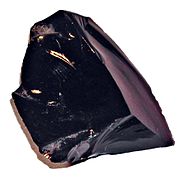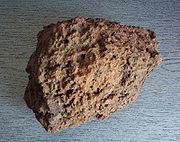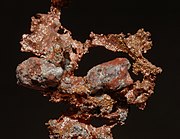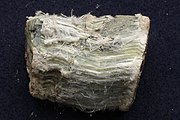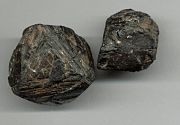Difference between revisions of "AY Honors/Sand/Answer Key"
({{AY Master|Conservation}}) |
(russian interwiki) |
||
| (12 intermediate revisions by the same user not shown) | |||
| Line 1: | Line 1: | ||
| − | {{ | + | {{dablink|This article is about the terminology used to describe fracture surfaces. For fractures in rocks and minerals ''per se'', see [[Fracture (geology)]]}} |
| − | |||
| − | |||
| − | |||
| − | |||
| − | |||
| − | |||
| − | |||
| − | |||
| − | |||
| − | |||
| − | |||
| − | |||
| − | |||
| − | |||
| − | |||
| − | |||
| − | |||
| − | |||
| − | |||
| − | |||
| − | |||
| − | |||
| − | |||
| − | |||
| − | |||
| − | |||
| − | |||
| − | |||
| − | |||
| − | |||
| − | |||
| − | |||
| − | |||
| − | |||
| − | |||
| − | |||
| − | [[ | + | In the field of [[mineralogy]], '''fracture''' is a term used to describe the shape and texture of the surface formed when a [[mineral]] is broken. Minerals often have a highly distinctive fracture, making it a principal feature used in their identification. |
| + | |||
| + | Fracture differs from [[Cleavage (geology)|cleavage]] in that that the latter involves clean splitting along the [[Cleavage (crystal)|cleavage planes]] of the mineral's crystal structure, as opposed to more general breakage. All minerals exhibit fracture, but when very strong cleavage is present, it can be difficult to see. | ||
| + | |||
| + | ==Terminology== | ||
| + | |||
| + | ====Conchoidal fracture==== | ||
| + | [[Image:ObsidianOregon.jpg|thumb|left|180px|[[Obsidian]]]] | ||
| + | '''[[Conchoidal fracture]]''' is a curved breakage that resembles the concentric ripples of a [[mussel]] shell. It often occurs in amorphous or fine-grained minerals such as [[flint]], [[opal]] or [[obsidian]], but may also occur in crystalline minerals such as [[quartz]]. '''Subconchoidal fracture''' is similar to conchoidal fracture, but not as curved. | ||
| + | <br clear="all" /> | ||
| + | |||
| + | ====Earthy fracture==== | ||
| + | [[Image:Limonite_bog_iron_cm02.jpg|thumb|left|180px|[[Limonite]]]] | ||
| + | '''Earthy fracture''' is reminiscent of freshly broken [[soil]]. It is frequently seen in relatively soft, loosely bound minerals, such as [[limonite]], [[kaolinite]] and [[aluminite]]. | ||
| + | <br clear="all" /> | ||
| + | |||
| + | ====Hackly fracture==== | ||
| + | [[Image:Cuivre_natif1_%28USA%29.jpg|thumb|left|180px|[[Native copper]]]] | ||
| + | '''Hackly fracture''' (also known as '''jagged fracture''') is jagged, sharp and uneven. It occurs when metals are torn, and so is often encountered in [[native metal|native metals]] such as [[Native copper|copper]] and [[silver]]. | ||
| + | <br clear="all" /> | ||
| + | |||
| + | ====Splintery fracture==== | ||
| + | [[Image:Chrysotile_1.jpg|thumb|left|180px|[[Chrysotile]]]] | ||
| + | '''Splintery fracture''' comprises sharp elongated points. It is particularly seen in fibrous minerals such as [[chrysotile]], but may also occur in non-fibrous minerals such as [[kyanite]]. | ||
| + | <br clear="all" /> | ||
| + | |||
| + | ====Uneven fracture==== | ||
| + | [[Image:MagnetitaEZ.jpg|thumb|left|180px|[[Magnetite]]]] | ||
| + | '''Uneven fracture''' is self descriptive. It occurs in a wide range of minerals including [[arsenopyrite]], [[pyrite]] and [[magnetite]]. | ||
| + | <br clear="all" /> | ||
| + | |||
| + | ==See also== | ||
| + | *[[Fracture]] | ||
| + | *[[Fracture (geology)]] | ||
| + | *[[Conchoidal fracture]] | ||
| + | |||
| + | ==References== | ||
| + | * Rudolf Duda and Lubos Rejl: ''Minerals of the World'' (Arch Cape Press, 1990) | ||
| + | * http://www.galleries.com/minerals/property/fracture.htm | ||
| + | |||
| + | |||
| + | {{Template: Mineral identification}} | ||
| + | |||
| + | [[ru:Излом]] | ||
Revision as of 18:19, 5 May 2008
In the field of mineralogy, fracture is a term used to describe the shape and texture of the surface formed when a mineral is broken. Minerals often have a highly distinctive fracture, making it a principal feature used in their identification.
Fracture differs from cleavage in that that the latter involves clean splitting along the cleavage planes of the mineral's crystal structure, as opposed to more general breakage. All minerals exhibit fracture, but when very strong cleavage is present, it can be difficult to see.
Terminology
Conchoidal fracture
Conchoidal fracture is a curved breakage that resembles the concentric ripples of a mussel shell. It often occurs in amorphous or fine-grained minerals such as flint, opal or obsidian, but may also occur in crystalline minerals such as quartz. Subconchoidal fracture is similar to conchoidal fracture, but not as curved.
Earthy fracture
Earthy fracture is reminiscent of freshly broken soil. It is frequently seen in relatively soft, loosely bound minerals, such as limonite, kaolinite and aluminite.
Hackly fracture
Hackly fracture (also known as jagged fracture) is jagged, sharp and uneven. It occurs when metals are torn, and so is often encountered in native metals such as copper and silver.
Splintery fracture
Splintery fracture comprises sharp elongated points. It is particularly seen in fibrous minerals such as chrysotile, but may also occur in non-fibrous minerals such as kyanite.
Uneven fracture
Uneven fracture is self descriptive. It occurs in a wide range of minerals including arsenopyrite, pyrite and magnetite.
See also
References
- Rudolf Duda and Lubos Rejl: Minerals of the World (Arch Cape Press, 1990)
- http://www.galleries.com/minerals/property/fracture.htm
